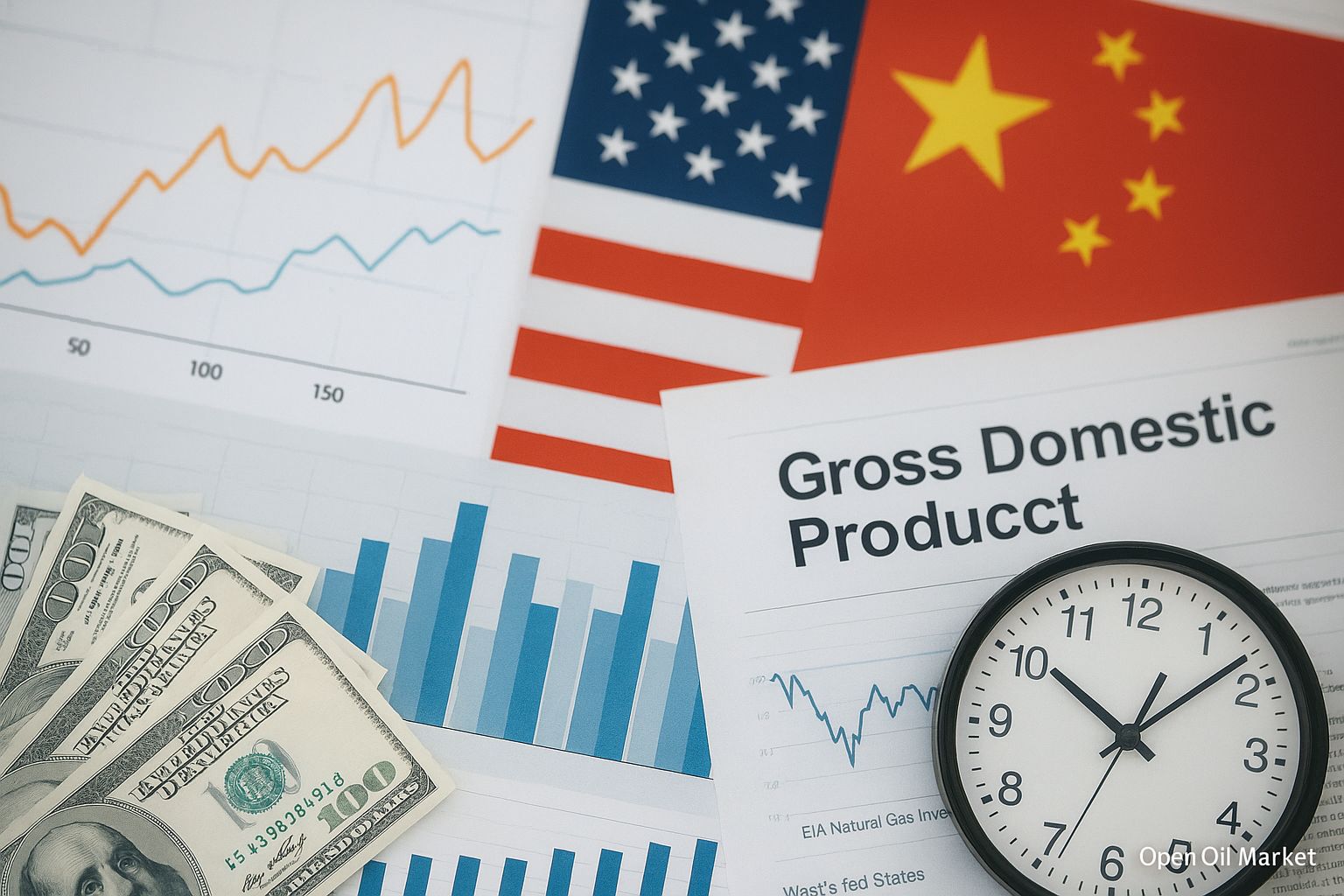
Detailed Review of Economic Events and Corporate Reports on October 31, 2025.
The last Friday of October promises to be eventful for global markets. In Asia, the APEC Summit kicks off in South Korea, where leaders from the Asia-Pacific region will discuss trade cooperation amid ongoing geopolitical risks. Simultaneously, investors receive fresh signals from China early in the morning: the official Purchasing Managers' Index (PMI) reflects a continued slowdown in the manufacturing sector and performance trends in the services sector. In Europe, the focus is on the preliminary CPI Inflation Estimate for October, the results of which will help gauge the European Central Bank's (ECB) steps following a series of tightening measures. North America will see the publication of the preferred inflation indicator for the Federal Reserve – the PCE Price Index – along with statistics on economic activity in the US and Canada. On the corporate front, the peak earnings season comes to a close: both major oil and gas companies in the US and representatives from pharmaceuticals, finance, and industry in the S&P 500, Euro Stoxx 50, Nikkei 225, and MOEX indices will report today. Overall, macroeconomic data on slowing inflation and corporate results will help investors in the CIS assess market sentiment — from monetary policy prospects to sectoral ideas in the stock market.
Macroeconomic Calendar (MST)
- 04:30 — China: official indices of business activity (Manufacturing, Non-Manufacturing, Composite PMI) for October.
- 13:00 — Eurozone: consumer inflation (CPI, October, preliminary data).
- 15:30 — USA: personal consumption expenditures (PCE Price Index) for September.
- 15:30 — Canada: gross domestic product (GDP) for August (m/m).
- 16:45 — USA: Chicago PMI for October.
Asia: PMI Data from China and APEC Summit Kicking Off
The Asian session begins with the publication of key indicators from China. The official Manufacturing PMI has remained below the threshold of 50 points for the seventh consecutive month, signaling a persistent decline in the manufacturing sector. A slight dip in the index is expected (around 49.5-49.7), indicating weak domestic and external demand for Chinese industrial goods. The Services PMI, in contrast, hovers around the 50 mark, reflecting a slowdown in growth in non-manufacturing sectors — the growth of services is no longer as robust as at the beginning of the year. Collectively, the Composite PMI is close to the neutral value of 50, demonstrating a lack of clear momentum in the Chinese economy. This data amplifies expectations for additional stimulus measures from Beijing and affects sentiment in commodity markets (metals, oil) that are sensitive to demand from China.
An additional factor for Asian markets is the APEC Summit starting today in Gyeongju, South Korea. During the first day of the meeting, leaders from 21 APEC economies will discuss the recovery of regional trade and investment cooperation. Particular attention is focused on potential bilateral negotiations between the major powers – specifically, a meeting between representatives of the US and China – amid cooling relations and protectionist trends. Investors are hoping to hear announcements about support for free trade and the digital economy. Any positive signals from the summit could enhance risk appetite in the Asia-Pacific markets, whereas a lack of progress or new trade disputes could intensify volatility and pressure on currencies of emerging economies.
Europe: Eurozone Inflation Continues to Slow
In the afternoon, the focus will shift to Europe, where the preliminary estimate of the consumer inflation CPI for the Eurozone for October will be released. It is expected that both headline and core inflation will continue to decline amid falling energy prices and weakened consumer demand. Economists forecast that the annual price growth may slow to its lowest levels in the past year and a half. If the data confirm a further decrease in indicators (for instance, headline CPI approaching around ~2% YoY), this will strengthen expectations that the ECB will refrain from raising rates at upcoming meetings. A slowdown in core inflation (excluding energy and food prices) is particularly important for the regulator: a trend on its decline indicates a weakening of fundamental price pressures in the economy.
For European markets, such favorable inflation news could serve as a growth driver. Slower inflation traditionally supports the bond market (yields on Eurozone government securities may decline) and improves the outlook for sectors sensitive to interest rates, such as real estate and auto lending. Additionally, moderate price growth enhances the real purchasing power of households, which is beneficial for retail and service companies. Investors will also monitor the inflation dynamics in major economies of the bloc – particularly Germany and France – to evaluate the degree of synchronized price pressure decline throughout the region. Should inflation slow more than expected, talks about potential stimulus measures from the ECB in the longer term could arise, although the official rhetoric of the regulator remains cautious for now.
USA: PCE Indicator Signals Decreasing Price Pressure
The American macroeconomic agenda focuses on inflation and business activity. At 15:30 MST, the US Department of Commerce will release data on spending and income, including the PCE Price Index for September. This indicator—especially its core part (Core PCE)—is considered key for the Federal Reserve when assessing inflationary risks. Projections indicate a further slowdown in year-on-year growth of PCE prices due to falling housing costs and stable service prices. If the data confirm this trend (for instance, core PCE edging closer to the target of 2% on a year-over-year basis), market participants will become more convinced that the Fed may pause rate hikes or even shift to easing policy next year. This, in turn, may weaken Treasury yields and the dollar, supporting the growth stock segment in the US market.
In addition to inflation data, investors will analyze business activity indicators. The Chicago Purchasing Managers' Index (Chicago PMI) for October, published closer to the evening, will provide an assessment of the state of industry in the US Midwest. A slight rise in the index is expected after a slump to 40.6 points in September—forecasts suggest the index could improve to around 42-43. While the value will remain deep in contraction territory (below 50 points), the mere fact of improvement signals a possible bottoming out in the regional manufacturing cycle. Nevertheless, the 22nd consecutive month of negative Chicago PMI values highlights the ongoing difficulties in the US manufacturing industry: weak corporate demand, high inventory levels, and business caution amid previous Fed rate hikes. For a complete picture, investors will also consider fresh data on employment and consumer spending from the accompanying report (personal incomes and expenditures of Americans for September), which will help calibrate expectations before the release of broader indicators, such as ISM and the labor market report next week.
Canada: GDP Stagnation Signals the Bank of Canada
Concurrently with the American PCE, vital economic data from Canada will be released—a monthly report on GDP for August. According to the preliminary estimate from the statistical agency, the Canadian economy saw virtually no growth at the end of summer (GDP change is expected to be around 0.0-0.1% m/m). This stagnation in Canada's industrial and resource sector reflects the impact of high-interest rates and weakened external demand, particularly from the US and China. If the official data confirm the absence of growth, it will mark the third consecutive month of near-zero dynamics, indicating waning economic activity. For the Bank of Canada, such a signal provides an additional argument for maintaining the current rate unchanged: amid a cooling economy, the regulator is unlikely to pursue further tightening of monetary policy.
Market reaction to the Canadian GDP will primarily impact the Canadian dollar (CAD) and the local bond market. Persisting economic weakness may result in a moderate decline of CAD against major currencies, considering the prospect of a softer policy from the Bank of Canada. Meanwhile, Canadian stocks (especially in the banking and real estate sectors) may receive support on expectations of future rate cuts. Investors will also monitor accompanying data—such as sectoral details from the report (mining, processing, services)—to determine which sectors are dragging the economy down. Overall, the combination of stagnant GDP and easing inflation in North America creates a favorable backdrop for bond markets and bolsters confidence that the peak in interest rates has already been reached.
Oil and Gas Giants' Reports: ExxonMobil and Chevron
The culmination of corporate reporting this Friday will be the results from the largest oil and gas companies in the US—ExxonMobil and Chevron. These energy sector titans (part of the S&P 500 index) will publish their financial results for the third quarter before the opening of the American market. Analysts anticipate a decline in revenue and profits on a year-over-year basis, driven by lower oil and gas prices compared to last year’s record levels. However, investors will be particularly interested in business margins and capital distribution plans. Despite the revenue downturn, both ExxonMobil and Chevron are expected to reaffirm their generous dividends and substantial share buyback programs—this is an important factor in their attractiveness for long-term investors.
Market focus will also be on operational details. ExxonMobil may provide updated information on its major oil projects (including shale production in the Permian Basin and offshore development in Guyana) and report progress in its petrochemical business. Chevron is expected to comment on production in the Permian region and downstream segment performance (refining and distribution of petroleum products), where margins could have improved due to rising fuel demand. Any surprises—such as better-than-expected free cash flow results or changes in capital expenditure guidance—have the potential to cause significant movement in these companies' shares and affect the entire energy sector. Moreover, the results from Exxon and Chevron will serve as bellwethers for the global oil and gas industry: their reports will reflect how well the industry adapts to price volatility and more stringent cost control measures.
Other Corporate Reports of the Day
In addition to the oil and gas sector, October 31 is filled with financial releases across various industries worldwide. In the US, several companies from the S&P 500 index and beyond will report results:
- AbbVie (ABBV) – a pharmaceutical giant. Investors are monitoring sales trends of key medications, especially new immunological agents that are compensating for the revenue decline from aging patents. The focus will be on profit forecasts amidst competition in the biotech segment.
- Aon plc (AON) – a global leader in insurance brokerage and risk management. The company’s results will provide insight into the state of the insurance market: growth in commission income and the impact of higher interest rates (through investment income from insurance reserves) will be key metrics.
- Colgate-Palmolive (CL) – a large FMCG company in the consumer goods sector. Its quarterly sales and profit figures will show how price changes and improving consumer sentiment in the US and Europe affect demand for everyday products. Separately, investors will assess margin levels: whether Colgate can maintain profitability amid declining raw material and logistics costs.
- Linde plc (LIN) – the world's largest industrial gas company (part of the S&P 500 and previously DAX 30). Linde's report becomes an indicator of global industrial activity: demand from the electronics, healthcare, and chemistry sectors. Synergy metrics following its merger with Praxair and free cash flow projections will be essential for assessing business resilience.
- Canadian National Railway (CNR) – a railway operator in Canada and the US. The financial results of this transport company reflect the volumes of freight transport in North America, thus indirectly indicating economic activity. Investors will look at freight traffic dynamics (transport of oil, grain, consumer goods) and cost efficiency, especially amid potential strike activity or weather risks.
- Dominion Energy (D) – one of the largest energy utilities in the US. Its report will provide insight into electricity and gas demand trends and the impact of interest rates on the highly indebted utility sector. Key points will be strategies for reducing debt load, progress on infrastructure projects, and management comments on tariff regulations.
In Europe and Asia, October 31 sees a less dense stream of reports, as the bulk of releases occurred earlier in the week. Nevertheless, investors continue to digest previously published results from corporations such as European banks and industrial conglomerates, as well as reports from Japanese exporters. In the Russian market, the quarterly reporting season is nearing its conclusion: major issuers on the MOEX reported profits for the past nine months earlier or will present data in early November. No significant corporate releases are expected in Russia today, so Russian investors are more focused on macroeconomic signals—such as the latest inflation data for October and the prospects for the Bank of Russia’s policy. Overall, the breadth of corporate events on October 31—ranging from American tech firms to Asian manufacturers—provides a comprehensive picture of the state of the global economy at the end of the quarter.
Day's Summary: What Investors Should Pay Attention To
- Global Inflation Decline: today key price indicators are released—CPI in Europe and PCE in the USA. Their slowdown confirms the trend of easing inflation, which is crucial for forecasts regarding the FOMC and ECB rates. Investors should evaluate how the data aligns with expectations: lower inflation will support growth in bonds and stocks, while an unexpected spike might temporarily cool the market.
- Signals from Asia: business activity in China (PMI) and news from the APEC summit set the tone for Asian assets and commodities. A sustained weak PMI will indicate the need for stimulus and may pressure metal and oil prices, while diplomatic successes at APEC could enhance investor sentiment. Those investing in Asian markets or commodities should consider these factors in their decision-making process.
- Energy Sector in Focus: reports from ExxonMobil and Chevron will clarify the state of the oil and gas sector. Importantly, it is not just the profit figures (which are expected to be lower than last year's) that matter, but comments on cash flows, dividends, and investments. The response of energy stocks will signal the entire energy segment, including high-yield bonds and commodity-linked currencies (like the Canadian dollar and Russian ruble).
- Corporate Surprises: a wide range of companies from the US and other regions (from pharmaceuticals to industrials) are publishing results that could move individual stocks and sectors. Investors should track whether these firms exceeded expectations or downgraded forecasts—this will help timely adjust portfolio composition, increasing exposure to promising sectors or reducing exposure to troubled industries.
- Risk Management on a Volatile Day: the last day of the month combines several significant events, which could lead to elevated price fluctuations. It is advisable to pre-determine key levels for positions, utilize stop orders, and limit orders. Increased attention to correlations (such as between bond yields and the tech sector, or between oil prices and currencies) will enable quick responses to emerging news and protect capital from unexpected volatility.




